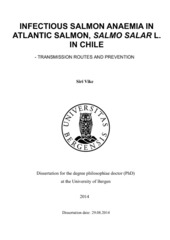| dc.contributor.author | Vike, Siri | eng |
| dc.date.accessioned | 2014-09-04T11:43:58Z | |
| dc.date.available | 2014-09-04T11:43:58Z | |
| dc.date.issued | 2014-08-29 | eng |
| dc.identifier.isbn | 978-82-308-2856-4 | en_US |
| dc.identifier.uri | http://hdl.handle.net/1956/8409 | |
| dc.description.abstract | Infectious salmon anaemia (ISA) virus causes a severe, commercially significant disease in all countries farming Atlantic salmon (Salmo salar). This thesis examines the ISA epizootic in Chile during 2007-09, known as the “ISA crisis”. Three important questions were addressed. First, how did the ISA virus arrive in Chile? Second, how was the virus spread within the industry after arrival? And third, what would be the best preventive measures to control the spread of this virus? Phylogenetic comparison of ISA virus from Chile with all available ISA virus strains showed a close relationship to European ISA virus. The best explanation for this observation is that the ISA virus arrived in Chile with its natural host, Atlantic salmon – through import of embryos. Once in Chile the ISA virus spread rapidly due to the industrial and sanitary practices such as the continuous productions in both freshwater lakes and at sea sites with no generational splits, and movement of fish between sites. At some sites the salmon were weakened due to high stocking densities and the presence of additional pathogens. It was found that the sea louse, Caligus rogercresseyi could act as a mechanical vector, and possibly contributed to the spread of the virus. In contrast, the survival time of ISA virions in natural sea water was found to be less than three hours (under experimental conditions), and therefore waterborne transmission over long distances was considered to be unlikely. In addition, ISA mortalities were contagious for up to five days post mortem, emphasizing the importance of dead fish removal. ISA virus is present in the natural wild reservoir of S. salar and S. trutta in the North Atlantic. However, both in Chile and Norway it is likely that the farming industry accommodate a self-sustaining reservoir of ISA virus. Thus the industry has a possibility to reduce the prevalence by pathogen monitoring and elimination of positive broodfish. Good surveillance programmes can predict ISA outbreaks, and site management can diminish the significance of ISA outbreaks. The key for this is tracing the pathogen throughout the production cycle and implementing appropriate preventative measures, instead of waiting for clinical symptoms to appear and then activate the associated “fire fighting” approach. | en_US |
| dc.language.iso | eng | eng |
| dc.publisher | The University of Bergen | en_US |
| dc.relation.haspart | Paper I: Vike, S., Nylund, S., Nylund, A. (2009). ISA virus in Chile: evidence of vertical transmission. Archives of Virology, 154, 1-8. Full text not available in BORA due to publisher restrictions. The article is available at: <a href="http://dx.doi.org/10.1007/s00705-008-0251-2" target="blank">http://dx.doi.org/10.1007/s00705-008-0251-2</a>. | en_US |
| dc.relation.haspart | Paper II: Vike, S., Oelckers, K., Duesund, H., Erga, S. R., Gonzalez, J., Hamre, B., Frette, Ø., Nylund, A. (2013). Infectious Salmon Anaemia (ISA) virus: Infectivity in seawater under different physical conditions. Journal of Aquatic Animal Health, 26, 33-42. Full text not available in BORA due to publisher restrictions. The article is available at: <a href="http://dx.doi.org/10.1080/08997659.2013.864720" target="blank">http://dx.doi.org/10.1080/08997659.2013.864720</a> | en_US |
| dc.relation.haspart | Paper III: Oelckers, K., Vike, S., Duesund, H., Gonzalez, J., Wadsworth, S., Nylund, A (2014). Caligus rogercresseyi as a potential vector for transmission of Infectious Salmon Anaemia (ISA) virus in Chile. Aquaculture, 420-421, 126-132. Full text not available in BORA due to publisher restrictions. The article is available at: <a href="http://dx.doi.org/10.1016/j.aquaculture.2013.10.016" target="blank">http://dx.doi.org/10.1016/j.aquaculture.2013.10.016</a> . | en_US |
| dc.relation.haspart | Paper IV: Vike, S., Duesund, H., Andersen, L., Nylund, A. (2014). Release and survival of Infectious Salmon Anaemia (ISA) virus during decomposition of Atlantic salmon (Salmo salar L.) Aquaculture, 420-421, 119-125. Full text not available in BORA due to publisher restrictions. The article is available at: <a href="http://dx.doi.org/10.1016/j.aquaculture.2013.09.043" target="blank">http://dx.doi.org/10.1016/j.aquaculture.2013.09.043</a> . | en_US |
| dc.title | Infectious salmon anaemia in Atlantic salmon, Salmo salar L. in Chile – transmission routes and prevention | en_US |
| dc.type | Doctoral thesis | |
| dc.rights.holder | Copyright the author. All rights reserved | en_US |
| dc.identifier.cristin | 1150276 | |
